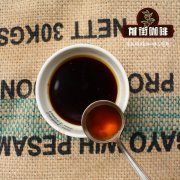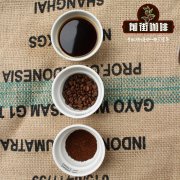Peru Organic Coffee Cultivation_Organic Coffee Bean Flavor Characteristics_Organic Coffee Is Good to Drink

Professional coffee knowledge exchange more coffee bean information please follow the coffee workshop (Wechat official account cafe_style)
Peru is located in western South America, bordering the South Pacific Ocean, between Chile and Ecuador. Peru has a very diverse climate, from the tropics in the east to the dry deserts in the west, and from the temperate zone to the cold of the Andes. Different climates are closely linked to the main geographical areas of Peru, including the western coastal plains, the central Andes, and the lowland jungles of the eastern Amazon basin.
Although coffee arrived in Peru in the mid-1700, Peruvian coffee did not begin to be exported commercially until the 20th century, when European demand increased and Indonesian coffee production declined significantly. Britain's presence and influence in the country particularly helped to increase and promote exports; at the beginning of the 20th century, the British government bought about 2 million hectares of land from the Peruvian government as payment of defaulted loans, most of which became British-owned coffee plantations.
Today, Peru has more than 110000 coffee growers. Peru's coffee exports account for 2% of the national economy and 2% of the global coffee supply. Peru is rapidly building a coffee industry chain with excellent planting technology.
Peruvian coffee exports
Peru exports 80% of its coffee to the port of Cayao (Callao), which accounts for 3% of imports and 1% of exports. Another 20 per cent of coffee is exported to Iquitos and Matarani respectively.
Most of the coffee produced in Peru is exported. In 2012, 264343 tons of coffee were exported to the United States, Germany, Belgium, Colombia, Sweden and other countries, while domestic consumption was only about 10 per cent. In 2014, coffee leaf rust (see El Salvador for specific information on leaf rust) affected 130000 hectares of land in the central highlands of the country, resulting in a 6 per cent drop in production in 2013; a shortfall of 15 per cent compared with a peak production of 30900 tons.
Peru's coffee industry is one of the most important agricultural sectors in the country, accounting for 12 per cent of all agricultural exports in 2004. Peru is also one of the largest coffee producers in the world, exporting more than 216 million kilograms in 2006. In addition, Peru is one of the major producers of organic and fair trade coffee beans in the world. These exports make Peru the ninth largest coffee producer in the world, but only the third largest coffee exporter in South America.
Arabica coffee is grown on about 200000 farms in Peru. Most of these farms are small, with an average area of less than 2 hectares. Most coffee is processed through cooperatives and then distributed through several middlemen before being exported.
Development of Organic Coffee in Peru
Like many Central and South American countries, throughout the 20th century, as large European-owned land was sold or redistributed, farms became smaller and more dispersed, providing farmers with independent opportunities while at the same time limiting their access to resources and larger commercial markets. However, there is a lack of organizations or infrastructure to provide economic or technical support to farmers, and non-governmental organizations and certification bodies are trying to fill this gap.
The country has a considerable number of organic coffee certification, Fair Trade Certification (Fairtrade), Rainforest Alliance (Rainforest Alliance) certification, and UTZ certification (UTZ certification, also known as international quality certification). About 30% of small farmers are members of democratic cooperatives, which increases the local popularity of coffee, but does not bring people incredibly high-quality products.
Rainforest Alliance (Rainforest Alliance)
Fair Trade Certification (Fairtrade)
UTZ certification
In the 2010s, Peru was one of the major producers of Arabica coffee and ranked fifth in the world's production and export of Arabica coffee. The remoteness of coffee farms and the unbelievably small size of ordinary farms have hindered the differentiation of many single farms, which has enabled microbial development and marketing in other growing areas. The country's lush highlands and excellent heirloom varieties provide growers with the potential to overcome limited infrastructure and market access barriers, and as production increases, we are more likely to see these types of progress.
Peruvian coffee farmers have a small land area, and the country's typical micro-wet milling operation (micro-wet-milling operation) is even smaller. From May to September, farmers pick ripe coffee cherries and transport them to manual pulpers and wooden fermentors. (in Peru, coffee is processed mainly by wet grinding on plantation land. In the process, the moisture content of coffee beans is reduced to about 20%, and then transported to the drying plant. However, this decentralized system is detrimental to coffee-growing areas in northern Peru, as it leads to inconsistencies in quality and promotes decay and fungal growth. )
After processing the coffee, most farmers walk or ride mules to the nearest town to sell coffee-a trip that can take 30 minutes to eight hours. On Saturday, the nearest town square became a buying and selling station for nearby remote coffee growers. Farmers sell their coffee and buy the goods they need before returning to the mountains.
In some shopping squares, very unfortunate but extremely common things happen-sometimes only one buyer arrives. This has greatly reduced the price of coffee paid to farmers. Since there is no individual warehouse space and only unreliable and expensive collective warehouses, farmers usually have no choice but to accept lower prices. The more remote the farm, the more coffee is mixed and traded before it reaches the coast. This unorganized trading system and isolation alienated farmers from the final drinks from their farms. For years, growers have been trying to exchange the weight of coffee with parchment in dollars. This completely cuts off their idea of producing a drink that can be enjoyed, or will give up based on its quality. Intermediate traders even add weight by sprinkling sand and water into each bag.
Coffee cultivation in Peru
Peruvian coffee fields are mainly distributed in the areas of Cacumaca in the north, Cusco and Norp in the south. 70% of the coffee varieties are iron pickups, 20% are Kaddura, and the rest are Kadim and other varieties. About 75 per cent of coffee growing areas are located at elevations of 1-1800 metres above sea level, while 2000 plants per hectare are grown in shady areas. Agriculture is mainly done by small farmers, and the planting area of organic coffee is 90,000 hectares.
Peru, as the eighth largest coffee producer in the world, has found great business opportunities for organic coffee in Europe and the United States in the past decade, while coffee fields in the Peruvian mountains have no running water and electricity, and poor Indian farmers have been accustomed to organic cultivation since ancient times. up to now, they still cannot afford to buy or use pesticides and fertilizers. The authorities are taking advantage of the opportunity to develop the organic coffee industry, which is mentored and certified by the Government. If they meet the requirements, organic certificates will be issued to facilitate export.
Peruvian organic coffee has low production costs, making it the world's largest and cheapest exporter of organic coffee. The other two major organic coffee producers are Mexico and Ethiopia, but at higher prices. The authorities intend to develop Peru into the world's leading organic coffee country, just as Vietnam is the world's largest producer of Robusta, but the floor price strategy has caused resentment in many producing countries. Although Peru dumps organic coffee at a low price, this does not mean that boutique coffee is extinct. In the 2010 SCAA Coffee of the year cup test, the tin card produced by Cecovasa in Tunkimayo, a small town in Puno, southeastern Peru, narrowly beat the rosy summer of the famous Panamanian emerald estate with a high score of 89.2, winning fifth place.
About CENFROCAFE
Founded in 1999, CENFROCAFE is one of the largest and most organized cooperative organizations in Latin America, with a presence in most parts of Peru. Despite the overall lack of a cohesive National Coffee Association or NGO, CENFROCAFE has been able to support nearly 2000 coffee growers by providing agricultural and financial resources, while encouraging producers to learn to roast and come into contact with professional coffee.
About 92 per cent of coffee sold through CENFROCAFE is organic; 100 per cent is certified as Fairtrade. This has led to an improvement in product quality and the demand for Peruvian organic coffee in the international market at competitive prices.
Qianjie coffee: Guangzhou bakery, the store is small but a variety of beans, you can find a variety of unknown beans, but also provide online store services. Https://shop104210103.taobao.com
Important Notice :
前街咖啡 FrontStreet Coffee has moved to new addredd:
FrontStreet Coffee Address: 315,Donghua East Road,GuangZhou
Tel:020 38364473
- Prev

Organic Coffee Bean Origin Story _ species introduction of Organic Coffee beans _ Organic Coffee Price
Professional coffee knowledge exchange more coffee bean information please follow the coffee workshop (Wechat official account cafe_style) organic coffee bean producing area story hand-selected 100% high-altitude coffee bean coffee field, the higher the altitude, the better the coffee quality. At present, many coffee beans billed as Arabica do not really come from high altitude, while organic coffee is pure.
- Next

The difference between organic coffee and inorganic coffee. Will organic coffee taste better? organic coffee beans are recommended.
Professional coffee knowledge exchange more information about coffee beans please follow the coffee workshop (Wechat official account cafe_style) Peru, the mysterious capital. It is bordered by Ecuador and Colombia to the north, Brazil and Bolivia to the east and Chile to the south, which is the main body of the ancient Inca empire. The western part of Peru is run through the Andes, belongs to the dry plateau climate, and travels eastward to the Amazon plain, belonging to damp.
Related
- Guji coffee producing area of Guji, Ethiopia: Humbela, Shakiso, Wulaga
- What is the most expensive variety of Qiloso in BOP multi-variety group?
- How to store the coffee beans bought home?
- Why are Yemeni coffee beans so rare now?
- Ethiopian Sidamo all Red Fruit Sun Sun Santa Vini Coffee beans
- SOE is mostly sour? What does it mean? Is it a single bean? what's the difference between it and Italian blending?
- Is Italian coffee beans suitable for making hand-brewed coffee?
- How to choose coffee beans when making cold coffee? What kind of coffee beans are suitable for making cold coffee?
- Just entered the pit to make coffee, what kind of coffee beans should be chosen?
- Can only Japan buy real Blue Mountain Coffee? What are authentic Jamaican Blue Mountain coffee beans?

